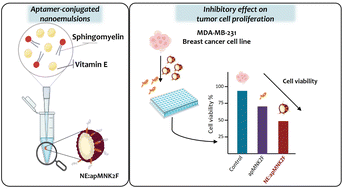Chemical conjugation of aptamer–sphingomyelin nanosystems and their potential as inhibitors of tumour cell proliferation in breast cancer cells†
Abstract
Breast cancer is a complex and heterogeneous disease with a high mortality rate due to non-specific cytotoxicity, low intratumoral accumulation and drug resistance associated with the ineffectiveness of chemotherapy. In recent years, all efforts have been focused on finding new markers and therapeutic targets, protein kinase MNK1b being a promising candidate. Recently, an aptamer known as apMNK2F showed a highly specific interaction with this protein kinase, leading to a significant reduction in tumour cell proliferation, migration and colony formation. However, as aptamers are unable to penetrate the cell membrane and reach the target, these small biomolecules need to be conjugated to suitable vectors that can transport and protect them inside the cells. In this work, covalent conjugation between biocompatible and non-harmful nanoemulsions of vitamin E and sphingomyelin and the aptamer was performed to facilitate intracellular delivery of the therapeutic aptamer apMNK2F. All strategies employed were based on 2-step bioconjugation and optimized to get the simplest and most reproducible vehicle with the highest association efficiency (about 70% in all cases). The ability of the nanosystems to successfully deliver the conjugated therapeutic aptamer was demonstrated and compared to other commercial transfection agents such as Lipofectamine 2000, leading to an effective decrease of breast cancer cell proliferation in the MDA-MB-231 cell line. The proliferation inhibition of the aptamer nanoconjugates compared to the non-conjugated aptamer provides evidence that the antitumoral capacity derived from kinase interaction is improved in a dose-dependent manner. Furthermore, various experiments including cell migration and colony formation assays, along with apoptosis induction experiments, emphasize the significant antitumoral potential. Overall, the obtained results indicate that the developed formulation could be a promising therapy for the treatment of breast cancer.

- This article is part of the themed collection: Emerging concepts in nucleic acids: structures, functions and applications


 Please wait while we load your content...
Please wait while we load your content...